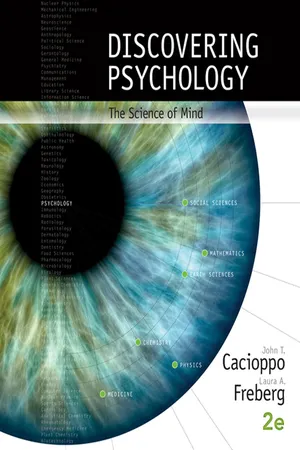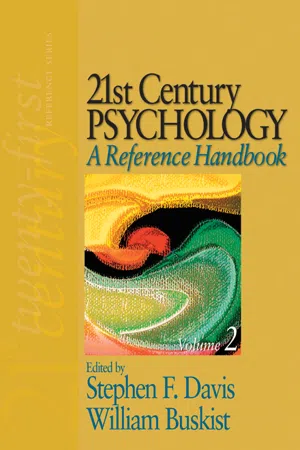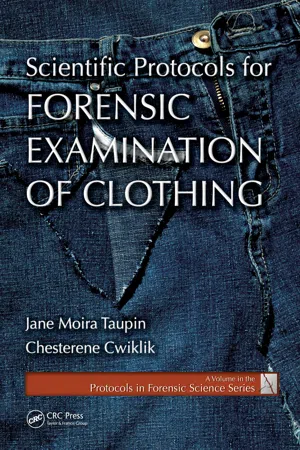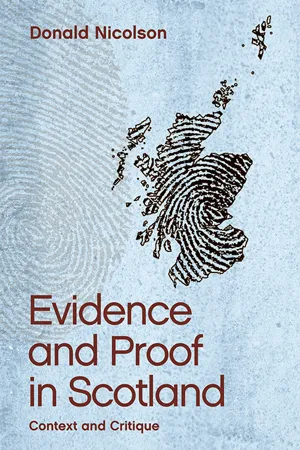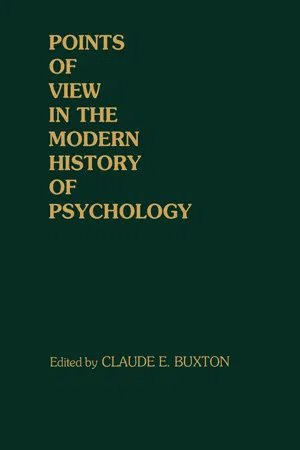Psychology
Biological Evidence
Biological evidence in psychology refers to the physical indicators of biological processes that influence behavior and mental processes. This evidence can include brain imaging, genetic markers, and physiological measures such as hormone levels. By studying biological evidence, psychologists can gain insights into the biological underpinnings of psychological phenomena, leading to a better understanding of human behavior and mental health.
Written by Perlego with AI-assistance
Related key terms
1 of 5
6 Key excerpts on "Biological Evidence"
- eBook - PDF
Discovering Psychology
The Science of Mind
- John Cacioppo, Laura Freberg(Authors)
- 2015(Publication Date)
- Cengage Learning EMEA(Publisher)
While investigating a particular behavior, the biological psychologist focuses on links between observed behavior and genetic factors, biochemical factors, and the activity level and structural characteristics of the nervous system. These links do not travel in one direction only, such as from biologi-cal factors to behavior, but are more accurately viewed as reciprocal. For example, we know that if you administer extra testosterone to human males, raising their testosterone so that AP Images/Matt Slocum Chapter 4 | THE BIOLOGICAL MIND: THE PHYSICAL BASIS OF BEHAVIOR Copyright 2016 Cengage Learning. All Rights Reserved. May not be copied, scanned, or duplicated, in whole or in part. Due to electronic rights, some third party content may be suppressed from the eBook and/or eChapter(s). Editorial review has deemed that any suppressed content does not materially affect the overall learning experience. Cengage Learning reserves the right to remove additional content at any time if subsequent rights restrictions require it. WHAT IS BIOLOGICAL PSYCHOLOGY? 107 it is above a normal level, they are likely to behave more aggressively (Pope, Kouri, & Hud-son, 2000). In this case, biology (raising testosterone levels) is influencing behavior (aggres-sion). However, we also know that watching his favorite sports team lose lowers a man’s testosterone level (Bernhardt, Dabbs, Fielden, & Lutter, 1998). Here, we see the influence of behavior (supporting a particular team and watching the team lose) on biology (testoster-one level). Early Attempts to Understand Biological Psychology Advances in the methods we use to observe the structure and function of the nervous system have driven the history of biological psychology. The discovery of contemporary methods, such as the recording and imaging of brain activity, opened new areas of inquiry to biological psychologists. - eBook - ePub
- G Neil Martin(Author)
- 2015(Publication Date)
- Routledge(Publisher)
1 What is Biological Psychology?What You Will Find in This Chapter
- ■ a definition of biological psychology and related disciplines
- ■ a brief description of the milestones in the history of biological psychology and neuroscience
- ■ a description of the scientific method and how this approach is adopted in biological psychology
What You Should Be Able to Do after Reading the Chapter
- ■ define biological psychology and describe what biological psychologists do
- ■ describe the scientific method and explain why it is the favoured method of study in biological psychology
- ■ be aware of the major discoveries and milestones in the history of neuroscience and biological psychology
1.1 Essential Biological Psychology
When you think of the term biological psychology, you probably have in mind a number of words and phrases: the body, the mind, the brain, thinking, understanding others, the title of this book. The phrase suggests a marrying of two scientific disciplines – biology and psychology – and, in a sense, this is correct.Biological psychology is the branch of psychology that investigates the biological bases of behaviour. From measuring heart rate in response to an emotional stimulus, to recording the activity of the brain during thinking or the activity of the hormones in the body in response to stress, to specifying the types of brain cell (or neuron) found in a region of the brain that is responsible for visual perception, the range of behaviours studied by biological psychologists is wide. For this reason, many of them specialise in a specific sub-area of biological psychology. For example, they may study the effects of the brain's chemicals on behaviour, the cell structure and organisation of the brain, the body's hormonal system, the blood flow or electrical activity of the brain during various tasks such as seeing, thinking, feeling, hearing, touching, and so on. Table 1.1 - Stephen F. Davis, William Buskist, Stephen F. Davis, William F. Buskist(Authors)
- 2007(Publication Date)
- SAGE Publications, Inc(Publisher)
Due to specific brain structures, humans see, hear, smell, taste, touch, and feel warmth, cold, pain, and pleasure. Through the process of introspection each of us with intact brains can become conscious of and ruminate on the complexity of our mental lives. We make moral judgments. Sitting on a mall bench we may also wonder about the minds of others. (Is that person by the department store who is talking to herself rehearsing a play, doing drugs, or suffering from a mental disorder? Should I be amused or concerned?) One benefit of studying people like Ron is that a malfunctioning brain makes us aware of the normal brain’s invisible activities. Until the past few hundred years or so, we couldn’t weigh happiness or memories in drams, nor poke and prod at dreams using tools other than words. But now we can. Biological psychology is the study of the mind, brain, and behavior of humans and other animals from evolutionary, behavioral genetic, physiological, and psychological perspectives. In part, biological psychology attempts to understand mind and consciousness by studying its underlying “physical sub-stance.” Neuroscientists study behavior in laboratory animals by measuring responses to brain manipulations using drugs, brain lesions, brain stimulation, and other intrusive techniques. Neuroscientists study humans as well as other animals. For example, the change in Ron’s behavior following removal of a tumor from his brain is an example of a brain-behavior relationship—an under-standing of the mind and behavior from the perspective of its underlying physiological and anatomical substrates (Kolb & Whishaw, 2004). Cognitive neuroscientists study perception, attention, memory, language, and conceptual processes using brain imaging, often in conjunction with other behavioral measures such as paper-and-pencil tests. An example would be to study the neural correlates of human memory using a brain-imaging technique such as functional magnetic resonance imaging (fMRI).- Jane Moira Taupin, Chesterene Cwiklik, Norah Rudin, Keith Inman(Authors)
- 2010(Publication Date)
- CRC Press(Publisher)
123 7 Human Biological Evidence Physiological fluids and biological material are the most common types of physical evidence found in violent crime. The advent of DNA typing, with the possibility of individualization, has increased their importance. This chapter will discuss the examination of blood, semen, and other human body substances that are deposited on clothing during the commission of a crime. Patterns of these substances (usually blood) are discussed in Chapter 5. Their com-position, especially if they can be DNA profiled, may be crucial in including or excluding any suspect and is discussed in this chapter. Although hairs are of a biological origin and may be DNA typed, they behave like fibers and are thus discussed in Chapter 8. The main objectives of Biological Evidence analysis are identification (or classifica-tion), individualization (DNA typing), and reconstruction. Classification of the evidence is determining whether it is blood, semen, or another bodily substance. Individualization of Biological Evidence is based on DNA typing, which is highly discriminating and has the power to attribute Biological Evidence to an individual with an extremely high degree of probability. Reconstruction of Biological Evidence is the interpretation of the pattern of the evidence, such as blood pattern analysis or the location of the semen stain with reference to the proposed crime scenario. Presumptive tests are used to screen stains or deposits on items of clothing that the examiner suspects may be the substance of interest; for example, blood or semen. These tests are sensitive but usually not specific for that material. Identification will require con-firmatory tests. Confirmatory tests are specific but are more time consuming and use more sample. Presumptive results should determine the most appropriate action for further test-ing and conservation of sample.- eBook - PDF
Evidence and Proof in Scotland
Context and Critique
- Donald Nicolson(Author)
- 2019(Publication Date)
- Edinburgh University Press(Publisher)
CHAPTER SIX The Psychological Context I: Witnesses and Truth 1 Introduction Having looked indirectly at documents and real evidence while exploring the scientific context of evidence and proof, we now turn to the other main form of evidence, namely the testimony of observational witnesses. As the first of two chapters devoted to the psychological context of evidence and proof, this chapter describes the two broad psychological processes rele-vant to witnessing, namely those involved in observing, remembering and recalling relevant facts, and those involved in evaluating the accuracy and honesty of these witnesses. Chapter Seven then explores the psychological processes involved in investigating, analysing, presenting and evaluating the facts relevant to a case as a whole, as opposed to individual items of evidence in the form of testimony, documents and real evidence. The fact that two chapters are devoted to psychology shows that it is central to the processes of evidence and proof 1 – almost by definition, as suggested by Bentham’s already quoted 2 definition of evidence as ‘any matter of fact, the effect, the tendency or design of which, when presented to the mind , is to produce a persuasion either affirmative or disaffirmative concerning the existence of some other matter of fact’. 3 Simply put, investigating and evaluating facts are impossible without psychological processes and hence these are central to our understanding of evidence and proof. - Claude E. Buxton(Author)
- 2013(Publication Date)
- Academic Press(Publisher)
12 Biological Contributions to the Development of Psychology KARL H. PRIBRAM AND DANIEL N. ROBINSON INTRODUCTION This chapter concerns several important influences that biology has had on the development of psychology as a science. Specifically, we attempt to account for an apparent paradox: In the nineteenth century, rapid advances were made in relating biology in general and brain func-tion in particular to the phenomena of mind. Throughout much of the first half of the twentieth century, however, these same relationships were all but ignored and the foundations for a scientific psychology were sought in the environment. The biological aspects of psychology, perhaps more than other special branches of the discipline, resist historical compression. Psychobiology, as we shall call the subject, 1 is deeply rooted in both philosophy and 1 There is still no universally accepted criterion for distinguishing among the terms physiological psychology, psychobiology, neuropsychology, and biopsychology. A grow-ing convention would reserve the term neuropsychology to theory about the human nervous system based on research involving complex cognitive processes, often in settings in which clinical findings are directly relevant. Physiological psychology strikes many as too restricted, for much current work falls under headings such as biophysics, computer science, or microanatomy that are synonymous with physiology. Thus, psychobiology is used here to refer to the broadest range of correlative studies in which biobehavioral investigations are undertaken and referenced to phenomenal experience. POINTS OF VIEW IN THE MODERN HISTORY OF PSYCHOLOGY 345 Copyright © 1985 by Academic Press, Inc. All rights of reproduction in any form reserved. ISBN 0-12-148510-2 346 Karl H. Pribram and Daniel N. Robinson biological science and was the subject of speculative and experimental psychology 2 centuries before Wundt christened the Leipzig laboratory (1874).
Index pages curate the most relevant extracts from our library of academic textbooks. They’ve been created using an in-house natural language model (NLM), each adding context and meaning to key research topics.
